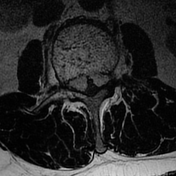Curtain sign (vertebral body mass)
Updates to Article Attributes
Body
was changed:
The Curtain sign (or Draped curtain sign) in neuroimaging refers to the appearance of a vertebral body mass that extends to the anterior epidural space.
The posterior longitudinal ligament is strongly attached to the vertebral body wall in its medial portion but it has a looser attachment laterally.
If a vertebral body lesion (e.g. a vertebral metastasis, vertebral hemangioma) extends posteriorly to the anterior epidural space, it displaces the posterior longitudinal ligament. However this is limited by that strong medial fixation, giving a bilobular intracanalar aspect in the axial images, which is commonly called Curtain sign (or Draped curtain sign).
-<p><strong>Curtain sign</strong> (or <strong>Draped curtain sign</strong>) in neuroimaging refers to the appearance of a vertebral body mass that extends to the anterior epidural space.</p>-<p>The <a title="posterior longitudinal ligament " href="/articles/posterior-longitudinal-ligament">posterior longitudinal ligament </a>is strongly attached to the vertebral body wall in its medial portion but it has a looser attachment laterally.</p>-<p>If a vertebral body lesion (e.g. a <a title="Vertebral metastasis" href="/articles/vertebral-metastases">vertebral metastasis</a>, <a title="vertebral hemangioma" href="/articles/primary-intraosseous-haemangioma">vertebral hemangioma</a>) extends posteriorly to the anterior epidural space, it displaces the posterior longitudinal ligament. However this is limited by that strong medial fixation, giving a bilobular intracanalar aspect in the axial images, which is commonly called <strong>Curtain sign </strong>(or <strong>Draped curtain sign</strong>).</p>- +<p>The <strong>Curtain sign</strong> (or <strong>Draped curtain sign</strong>) in neuroimaging refers to the appearance of a vertebral body mass that extends to the anterior epidural space.</p><p>The <a href="/articles/posterior-longitudinal-ligament">posterior longitudinal ligament </a>is strongly attached to the vertebral body wall in its medial portion but it has a looser attachment laterally.</p><p>If a vertebral body lesion (e.g. a <a href="/articles/vertebral-metastases">vertebral metastasis</a>, <a href="/articles/primary-intraosseous-haemangioma">vertebral hemangioma</a>) extends posteriorly to the anterior epidural space, it displaces the posterior longitudinal ligament. However this is limited by that strong medial fixation, giving a bilobular intracanalar aspect in the axial images, which is commonly called <strong>Curtain sign </strong>(or <strong>Draped curtain sign</strong>).</p>
Tags changed:
- refs
Systems changed:
- Spine
Images Changes:
Image 2 MRI (T2) ( update )

Caption
was added:
Spinal haemangioma: aggressive